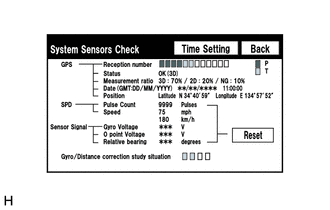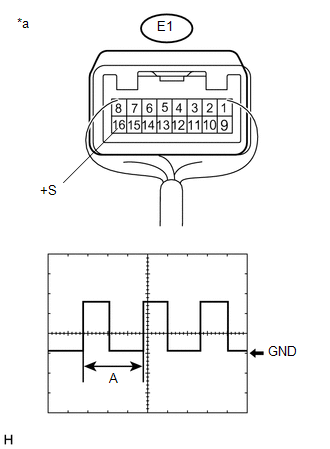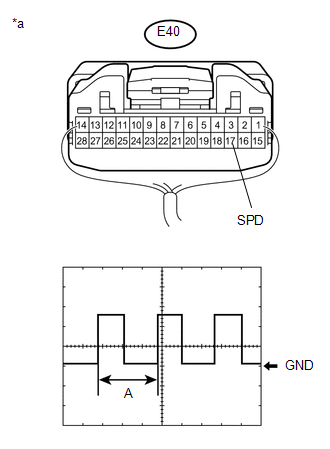Toyota Venza: Speed Signal Malfunction (B15C2)
DESCRIPTION
The navigation receiver assembly receives a vehicle speed signal from the combination meter assembly and information from the navigation antenna assembly, and then adjusts the vehicle position.
The navigation receiver assembly stores this DTC when the difference between the speed information that the navigation antenna assembly and the SPD pulse received from the combination meter assembly becomes large.
HINT:
- A voltage of 12 V or 5 V is output from each ECU and then input to the combination meter assembly. The signal is changed to a pulse signal at the transistor in the combination meter assembly. Each ECU controls its respective systems based on this pulse signal.
- If a short occurs in any of the ECUs or in the wire harness connected to an ECU, all systems in the following diagram will not operate normally.
|
DTC No. |
DTC Detection Condition |
Trouble Area |
|---|---|---|
|
B15C2 |
A difference between the GPS speed and SPD pulse is detected |
|
WIRING DIAGRAM
1. for 1AR-FE
.png)
2. for 2GR-FE
.png)
PROCEDURE
|
1. |
CHECK SYSTEM SENSORS (OPERATION CHECK) |
|
(a) Enter the "System Sensors Check" screen. Refer to Check System Sensors in Operation Check (See page
|
|
(b) While driving the vehicle, compare the value of "Speed" to the reading on the speedometer. Check if these readings are almost equal.
HINT:
The combination meter assembly receives the vehicle speed signal from the skid control ECU via CAN communication. Therefore, perform the following inspection referring to values on the Data List of the skid control ECU because it is the source of the vehicle speed signal.
OK:
Vehicle speed displayed on the "System Sensors Check" screen is almost the same
as the actual vehicle speed measured using the Techstream (See page
.gif) ).
).
| OK | .gif) |
REPLACE NAVIGATION RECEIVER ASSEMBLY |
|
|
2. |
INSPECT COMBINATION METER ASSEMBLY (OUTPUT WAVEFORM) |
|
(a) Check the output waveform. (1) Remove the combination meter assembly with the connector(s) still connected. (2) Connect an oscilloscope to terminal E1-16 (+S) and body ground. (3) Turn the ignition switch to ON. (4) Turn a wheel slowly. (5) Check the signal waveform according to the condition(s) in the table below.
OK: The waveform is similar to that shown in the illustration. HINT: When the system is functioning normally, one wheel revolution generates 4 pulses. As the vehicle speed increases, the width indicated by (A) in the illustration narrows. Text in Illustration
|
|
| NG | .gif) |
GO TO METER / GAUGE SYSTEM |
|
|
3. |
INSPECT NAVIGATION RECEIVER ASSEMBLY (INPUT WAVEFORM) |
|
(a) Check the input waveform. (1) Remove the navigation receiver assembly with the connector(s) still connected. (2) Connect an oscilloscope to terminal E40-17 (SPD) and body ground. (3) Turn the ignition switch to ON. (4) Turn a wheel slowly. (5) Check the signal waveform according to the condition(s) in the table below.
OK: The waveform is similar to that shown in the illustration. HINT: When the system is functioning normally, one wheel revolution generates 4 pulses. As the vehicle speed increases, the width indicated by (A) in the illustration narrows. |
|
|
*a |
Component with harness connected (Navigation Receiver Assembly) |
| OK | .gif) |
REPLACE NAVIGATION RECEIVER ASSEMBLY |
|
|
4. |
CHECK HARNESS AND CONNECTOR (NAVIGATION RECEIVER ASSEMBLY - JUNCTION CONNECTOR) |
(a) Disconnect the E40 navigation receiver assembly connector.
(b) Disconnect the E31 junction connector.
(c) Measure the resistance according to the value(s) in the table below.
Standard Resistance:
|
Tester Connection |
Condition |
Specified Condition |
|---|---|---|
|
E40-17 (SPD) - E31-20 |
Always |
Below 1 Ω |
| NG | .gif) |
REPAIR OR REPLACE HARNESS OR CONNECTOR |
|
|
5. |
CHECK HARNESS AND CONNECTOR (COMBINATION METER ASSEMBLY - JUNCTION CONNECTOR) |
(a) Disconnect the E1 combination meter assembly connector.
(b) Disconnect the E31 junction connector.
(c) Measure the resistance according to the value(s) in the table below.
Standard Resistance:
|
Tester Connection |
Condition |
Specified Condition |
|---|---|---|
|
E1-16 (+S) - E31-19 |
Always |
Below 1 Ω |
| OK | .gif) |
REPLACE JUNCTION CONNECTOR |
| NG | .gif) |
REPAIR OR REPLACE HARNESS OR CONNECTOR |
 Short in GPS Antenna (B15C0,B15C1)
Short in GPS Antenna (B15C0,B15C1)
DESCRIPTION
These DTCs are stored when a malfunction occurs in the navigation antenna assembly.
DTC No.
DTC Detection Condition
Trouble Area
B15C0
...
 Speaker Output Short (B15C3)
Speaker Output Short (B15C3)
DESCRIPTION
This DTC is stored when a malfunction occurs in the speakers.
DTC No.
DTC Detection Condition
Trouble Area
B15C3
A short is d ...
Other materials about Toyota Venza:
Diagnostic Trouble Code Chart
DIAGNOSTIC TROUBLE CODE CHART
HINT:
When the air conditioning system functions properly, DTC B1400/00 is output.
Air Conditioning System
DTC Code
Detection Item
Trouble Area
Memory*3
See page
...
Brake Switch "B" Circuit High (P0724)
DESCRIPTION
The purpose of this circuit is to prevent the engine from stalling when brakes
are suddenly applied while driving in lock-up condition.
When the brake pedal is depressed, the stop light switch sends a signal to the
ECM. Then the ECM cancels t ...
Diagnostic Trouble Code Chart
DIAGNOSTIC TROUBLE CODE CHART
HINT:
If a trouble code is stored during the DTC check, inspect the trouble areas listed
for that code. For details of the code, refer to the "See page" below.
1. CERTIFICATION ECU (SMART KEY ECU ASSEMBLY) DIAGNOSTI ...
0.1149


.gif)

